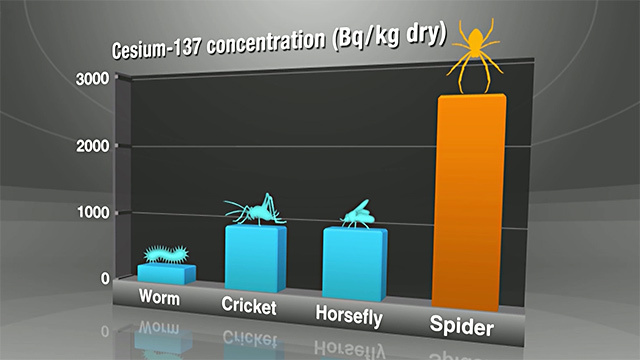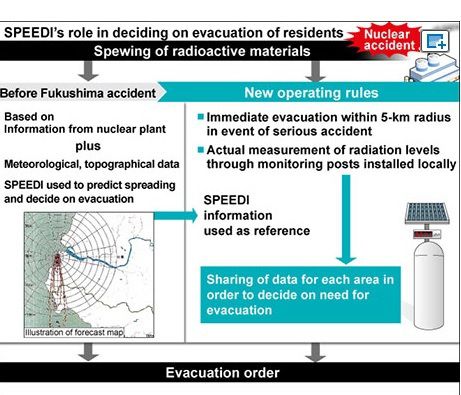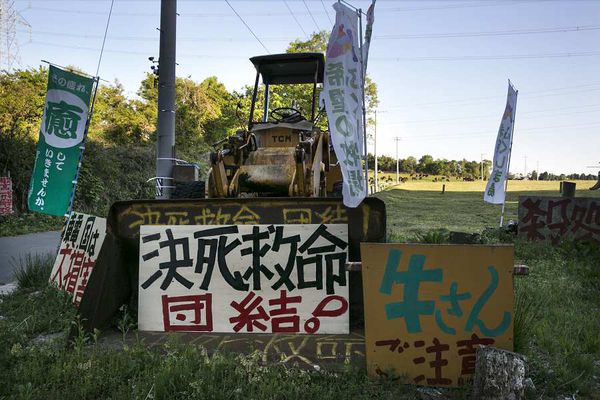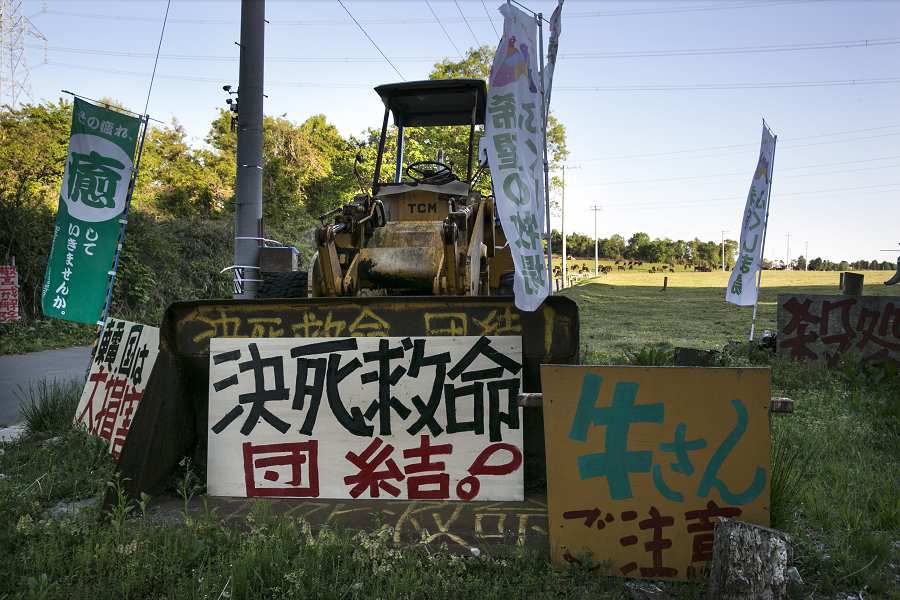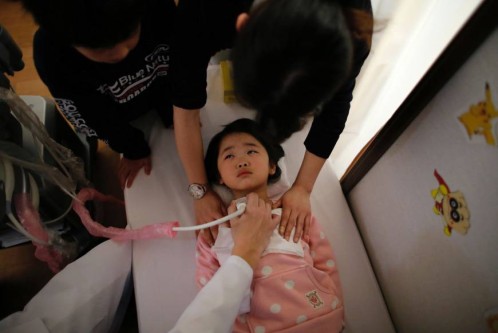August 15, 2014
The Ecosystem Are Being Slowly Revealed
http://www.businessinsider.com.au/the-serious-biological-effects-of-fukushima-radiation-on-plants-insects-and-animals-is-slowly-being-revealed-2014-8
Chris Pash Yesterday at 5:50 AM 421
Cattle graze in the distance at Masami Yoshizawa’s cattle farm where protest signs cover the landscape close to the devastated Fukushima plant. Masami Yoshizawa who runs the sanctuary, ‘Ranch of Hope’ for contaminated cattle, leads the movement among self-sacrificing farmers to protect cattle that were left behind in the exclusion zone in Fukushima after the nuclear disaster of Fukushima Daiichi Nuclear Power Plant following the earthquake and tsunami in March 11, 2011. (Photo by Paula Bronstein/Getty Images)
A range of scientific studies at Fukushima have begun to reveal the impact on the natural world from the radiation leaks at the power station in Japan caused by an earthquake and tsunami in 2011.
Biological samples were obtained only after extensive delays following the 1986 Chernobyl nuclear power plant meltdown, limiting the information which could be gained about the impact of that disaster.
Scientists, determined not to repeat the shortcomings of the Chernobyl studies, began gathering biological information only a few months after the meltdown of the Daiichi power plant in 2011.
Results of these studies are now beginning to reveal serious biological effects of the Fukushima radiation on non-human organisms ranging from plants to butterflies to birds.
A series of articles summarising these studies has now been published in the Journal of Heredity. These describe widespread impacts, ranging from population declines to genetic damage to responses by the repair mechanisms that help organisms cope with radiation exposure.
“A growing body of empirical results from studies of birds, monkeys, butterflies, and other insects suggests that some species have been significantly impacted by the radioactive releases related to the Fukushima disaster,” says Dr Timothy Mousseau of the University of South Carolina, lead author of one of the studies.
Common to all of the published studies is the hypothesis that chronic (low-dose) exposure to ionizing radiation results in genetic damage and increased mutation rates in reproductive and non-reproductive cells.
One of the studies documented the effects of radiation on rice by exposing healthy seedlings to low-level gamma radiation at a contaminated site in Fukushima Prefecture.
After three days, a number of effects were observed, including activation of genes involved in self-defense, ranging from DNA replication and repair to stress responses to cell death.
“The experimental design employed in this work will provide a new way to test how the entire rice plant genome responds to ionizing radiation under field conditions,” says Dr Randeep Rakwal of the University of Tsukuba in Japan, one of the authors of the study.
Another team of researchers examined the response of the pale grass blue butterfly, one of the most common butterfly species in Japan, to radiation exposure at the Fukushima site.
They found size reduction, slowed growth, high mortality and morphological abnormality both at the Fukushima site and among laboratory-bred butterflies with parents collected from the contaminated site.
“Non-contaminated larvae fed leaves from contaminated host plants collected near the reactor showed high rates of abnormality and mortality,” says Dr Joji Otaki of the University of the Ryukyus in Okinawa, Japan.
Some of their results suggested the possible evolution of radiation resistance in Fukushima butterflies as well.
This is a pale grass blue butterfly, one of the most common species of butterfly in Japan. Recent research has revealed major impacts on this species from the radiation leaks at the Fukushima nuclear power plant. Credit: Joji Otaki, University of the Ryukyus, Okinawa, Japan
A review of genetic and ecological studies for a range of other species at both Chernobyl and Fukushima (Mousseau 2014) revealed significant consequences of radiation. Population censuses of birds, butterflies, and cicadas at Fukushima showed major declines attributable to radiation exposure. Morphological effects, such as aberrant feathers on barn swallows, were also observed. The authors suggest that long-term studies at Chernobyl could predict likely effects in the future at the Fukushima site.
The scientists say there is an urgent need for greater investment in basic scientific research of the wild animals and plants of Fukushima.
Scientists detect genetic abnormalities in Fukushima birds, insects
http://www.japantimes.co.jp/news/2014/08/15/national/science-health/japan-u-s-warn-of-species-mutations-in-fukushima/#.U-78KmOnq1v
Kyodo
WASHINGTON – In a set of papers published Thursday in the Journal of Heredity, a U.S. publication, Japanese and U.S. scientists warned that radioactive materials released from by the core meltdowns at the Fukushima No. 1 power plant could have caused abnormalities in the genes of nearby birds and insects.
In a paper published on the journal’s website, Mousseau said barn swallows with abnormal white spots on their plumage were found near the Chernobyl plant after the disaster and that the discovery of similarly plumaged swallows in Fukushima was also reported in the wake of the 2011 crisis.
“Barn swallows with aberrant white feathers were first detected in Fukushima in 2012 and were observed in increasing frequencies in 2013 and 2014,” the paper said.
Mousseau is closely watching for signs of population decline in some birds due to abnormalities in mitochondrial DNA in areas near the Fukushima plant, since the same problem was reported in Chernobyl.
The poorly protected and maintained Fukushima plant, operated by Tokyo Electric Power Co., was extensively damaged by tsunami spawned by the Great East Japan Earthquake in March 2011 and suffered a blackout after losing its cooling systems.
High concentrations of radioactive materials spewed in the world’s worst nuclear accident since Chernobyl forced thousands of residents in Fukushima and elsewhere to flee.
Joji Otaki, associate professor at the University of the Ryukyus in Okinawa Prefecture, said in a separate paper in the same journal that abnormalities in the genes and sizes of pale grass blue butterflies were also detected. They were captured near the Fukushima plant.
Otaki said the abnormality rate for the butterfly, common in many parts of Japan, declined after peaking in September 2011 and that the finding could suggest the species possibly adjusted itself to the new environment and acquired radiation resistance after the meltdowns.
Cattle graze in the distance at Masami Yoshizawa’s cattle farm where protest signs cover the landscape close to the devastated Fukushima plant. Masami Yoshizawa who runs the sanctuary, ‘Ranch of Hope’ for contaminated cattle, leads the movement among self-sacrificing farmers to protect cattle that were left behind in the exclusion zone in Fukushima after the nuclear disaster of Fukushima Daiichi Nuclear Power Plant following the earthquake and tsunami in March 11, 2011. (Photo by Paula Bronstein/Getty Images)
A range of scientific studies at Fukushima have begun to reveal the impact on the natural world from the radiation leaks at the power station in Japan caused by an earthquake and tsunami in 2011.
Biological samples were obtained only after extensive delays following the 1986 Chernobyl nuclear power plant meltdown, limiting the information which could be gained about the impact of that disaster.
Scientists, determined not to repeat the shortcomings of the Chernobyl studies, began gathering biological information only a few months after the meltdown of the Daiichi power plant in 2011.
Results of these studies are now beginning to reveal serious biological effects of the Fukushima radiation on non-human organisms ranging from plants to butterflies to birds.
A series of articles summarising these studies has now been published in the Journal of Heredity. These describe widespread impacts, ranging from population declines to genetic damage to responses by the repair mechanisms that help organisms cope with radiation exposure.
“A growing body of empirical results from studies of birds, monkeys, butterflies, and other insects suggests that some species have been significantly impacted by the radioactive releases related to the Fukushima disaster,” says Dr Timothy Mousseau of the University of South Carolina, lead author of one of the studies.
Common to all of the published studies is the hypothesis that chronic (low-dose) exposure to ionizing radiation results in genetic damage and increased mutation rates in reproductive and non-reproductive cells.
One of the studies documented the effects of radiation on rice by exposing healthy seedlings to low-level gamma radiation at a contaminated site in Fukushima Prefecture.
After three days, a number of effects were observed, including activation of genes involved in self-defense, ranging from DNA replication and repair to stress responses to cell death.
“The experimental design employed in this work will provide a new way to test how the entire rice plant genome responds to ionizing radiation under field conditions,” says Dr Randeep Rakwal of the University of Tsukuba in Japan, one of the authors of the study.
Another team of researchers examined the response of the pale grass blue butterfly, one of the most common butterfly species in Japan, to radiation exposure at the Fukushima site.
They found size reduction, slowed growth, high mortality and morphological abnormality both at the Fukushima site and among laboratory-bred butterflies with parents collected from the contaminated site.
“Non-contaminated larvae fed leaves from contaminated host plants collected near the reactor showed high rates of abnormality and mortality,” says Dr Joji Otaki of the University of the Ryukyus in Okinawa, Japan.
Some of their results suggested the possible evolution of radiation resistance in Fukushima butterflies as well.
This is a pale grass blue butterfly, one of the most common species of butterfly in Japan. Recent research has revealed major impacts on this species from the radiation leaks at the Fukushima nuclear power plant. Credit: Joji Otaki, University of the Ryukyus, Okinawa, Japan
A review of genetic and ecological studies for a range of other species at both Chernobyl and Fukushima (Mousseau 2014) revealed significant consequences of radiation. Population censuses of birds, butterflies, and cicadas at Fukushima showed major declines attributable to radiation exposure. Morphological effects, such as aberrant feathers on barn swallows, were also observed. The authors suggest that long-term studies at Chernobyl could predict likely effects in the future at the Fukushima site.
The scientists say there is an urgent need for greater investment in basic scientific research of the wild animals and plants of Fukushima.

